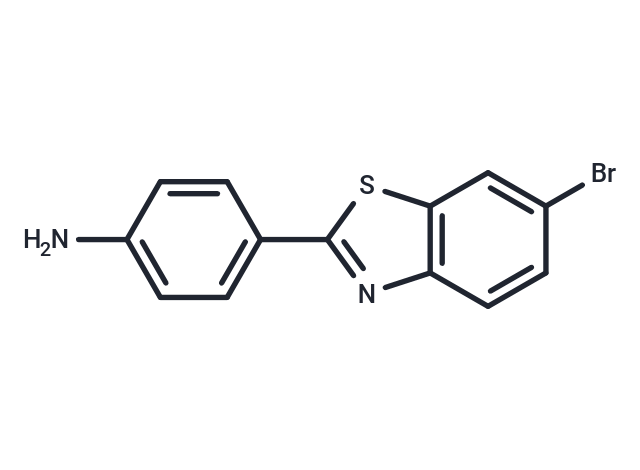Shopping Cart
- Remove All
 Your shopping cart is currently empty
Your shopping cart is currently empty

4-(6-Bromo-2-benzothiazolyl)benzenamine is a β-amyloid PET tracer used in the diagnosis of neurological diseases.

| Pack Size | Price | Availability | Quantity |
|---|---|---|---|
| 100 mg | Inquiry | Backorder | |
| 500 mg | Inquiry | Backorder |
| Description | 4-(6-Bromo-2-benzothiazolyl)benzenamine is a β-amyloid PET tracer used in the diagnosis of neurological diseases. |
| In vitro | Exposure of A375 cells to 4-(6-Bromo-2-benzothiazolyl)benzenamine (compound 6l) in conjunction with ultraviolet A (UVA) radiation activates caspase-3, initiates poly(ADP-ribose)polymerase cleavage, and causes M30 positive CytoDeath staining, leading to apoptotic cell death. This treatment also leads to a reduction in mitochondrial membrane potential (ΔΨmt), components of the oxidative phosphorylation system (OXPHOS), and adenosine triphosphate (ATP) levels, while increasing mitochondrial DNA 4977-bp deletions through the generation of reactive oxygen species (ROS) [2]. |
| In vivo | The combination of 4-(6-Bromo-2-benzothiazolyl)benzenamine and UVA exposure has been demonstrated to decrease the size of murine melanoma in a mouse model. This suggests that 4-(6-Bromo-2-benzothiazolyl)benzenamine-PDT could potentially act as an adjunctive treatment approach for melanoma [2]. |
| Cell Research | For fluorescence Measurement of Uptake of 4-(6-Bromo-2-benzothiazolyl)benzenamine, cultured A375 cells are seeded on glass coverslips with a density of 2×10^4 cells/well in 24-well plate for 24 h until cell attachment. Then the cells are exposed to 4-(6-Bromo-2-benzothiazolyl)benzenamine at 5 μM for indicated times in the dark. The cells are washed twice with PBS and are then fixed with 4% paraformaldehyde at 4°C for 30 min. The qualitative expression of cell fluorescence is determined using a Leica inverted microscope [2]. |
| Animal Research | A total of 5×10^6 B16 cells are inoculated into female ICR mice (about 19-21 g, 7 weeks). The subcutaneous inoculation of tumor cells resulted in tumor generation at the injection site. When tumors reached about 4×4 mm2 in diameter, mice are separated into groups. Each group had four mice in each experiment; 4 mg/kg of 4-(6-Bromo-2-benzothiazolyl)benzenamine is injected into the tumor site, and then the tumor is exposed to different doses of UVA on the day after injection. Tumor volume is measured by calipers every 5 days after agent injection, and tumor volume is calculated [2]. |
| Molecular Weight | 305.19 |
| Formula | C13H9BrN2S |
| Cas No. | 566169-97-9 |
| Relative Density. | no data available |
| Storage | Powder: -20°C for 3 years | In solvent: -80°C for 1 year | Shipping with blue ice. |

Copyright © 2015-2024 TargetMol Chemicals Inc. All Rights Reserved.